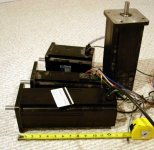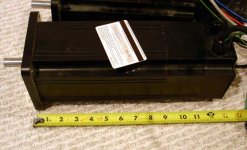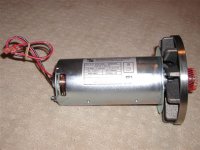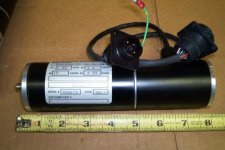cowanrg said:Audiophilenoob and others,
so, i have all these motors i want to try out. i really just want to 1) test them, 2) apply AC and see what happens.
all the motors i have are brushless DC servo motors. almost all would be beefy enough for this purpose, some would be INSANE, (2HP 230VDC servos).
anyways, most all of them have 4 large wires, and 5-6 wires (which are presumably the encoders). the large wires are always black, red, white, and green. how would i go about connecting those to an amplifier? or, better yet, how can i simply connect these in a manner to test them out?
this is something i would really like to tinker around with because i have the motors and i have a friend who builds large RC airplanes and has ability to vacuum carbon fibre and fiberglass. so, building a large, lightweight panel would be easy. i just want to toss something together to test it out and give it a whirl.
thanks!
I don't know man... the DC servo I have just has red and black leads coming off it
it's 280vdc with 2.25hp... brushless servo motors
do you have any sort of wiring diagram for the name of the company you can call and get a diagram from?
hum, mine all have 4, i checked. i was going to use them for a CNC project. i have over 200 of them and they are all various, so finding wiring diagrams proved to be quite difficult.
most are from companies that are no longer in business. and most all of them are custom, so i am not allowed to get the diagrams. but from what i understand, 4-wire servos are more common than 2-wire ones. a 2-wire servo (from what i remember) is really just a modified DC motor with an encoder. but i could be wrong. maybe mine just have 2 poles that need to be connected in paralell?
i have another post in another forum thats a bit more into servos so it should help. but im with you on this project. if i can get a motor working, ill start playing around.
do you have any pics of your motor, or dimensions?
most are from companies that are no longer in business. and most all of them are custom, so i am not allowed to get the diagrams. but from what i understand, 4-wire servos are more common than 2-wire ones. a 2-wire servo (from what i remember) is really just a modified DC motor with an encoder. but i could be wrong. maybe mine just have 2 poles that need to be connected in paralell?
i have another post in another forum thats a bit more into servos so it should help. but im with you on this project. if i can get a motor working, ill start playing around.
do you have any pics of your motor, or dimensions?
cowanrg said:hum, mine all have 4, i checked. i was going to use them for a CNC project. i have over 200 of them and they are all various, so finding wiring diagrams proved to be quite difficult.
most are from companies that are no longer in business. and most all of them are custom, so i am not allowed to get the diagrams. but from what i understand, 4-wire servos are more common than 2-wire ones. a 2-wire servo (from what i remember) is really just a modified DC motor with an encoder. but i could be wrong. maybe mine just have 2 poles that need to be connected in paralell?
i have another post in another forum thats a bit more into servos so it should help. but im with you on this project. if i can get a motor working, ill start playing around.
do you have any pics of your motor, or dimensions?
it's 2.5" around and 7.5" tall or so...
to be honest there's nothing I see wrong with just using DC motors if you have any... they should work fine... I don't even think they are necessarily less efficent then servos but I could be wrong about that
I see that... rather large...
those size of motors would not fit my purposes very well
my motor does weigh around 60-70lbs though not included the flange on the top
those size of motors would not fit my purposes very well
my motor does weigh around 60-70lbs though not included the flange on the top
wait, you said YOURS are rather large? but yours are 60-70lbs? that is HUGE. mine are as big as your forearm and only 28 pounds... whats going on here? did you have a typo?
a 70lb servo would be enormous...
a 70lb servo would be enormous...
cowanrg said:wait, you said YOURS are rather large? but yours are 60-70lbs? that is HUGE. mine are as big as your forearm and only 28 pounds... whats going on here? did you have a typo?
a 70lb servo would be enormous...
no no typo I dunno man
haha it's very very very heavy... it's got a LOT of torque... but it's only that large like I said...
it's 2.25hp and 280vdc but not as large as yours... I'm not sure... maybe this is just a normal DC motor that I have...
the seller said it was a servo... hmmmm
does it only have two wires coming out of it? if so, its just a DC motor...
do you have pictures? i can help identify it if you want. in any event, have you hooked it up to an amplifier to see what it does?
edit:
not to call you a liar or anything, but, i just modeled a solid block of cast allow steel in the same dimensions you quoted. it could be a maximum of 12 pounds. a solid block the same size as my motor would be around 180 pounds... even a SOLID block of lead would only be around 17 pounds.
so, its just not adding up in my head is all. HOW can it be that small and weigh that much...
do you have pictures? i can help identify it if you want. in any event, have you hooked it up to an amplifier to see what it does?
edit:
not to call you a liar or anything, but, i just modeled a solid block of cast allow steel in the same dimensions you quoted. it could be a maximum of 12 pounds. a solid block the same size as my motor would be around 180 pounds... even a SOLID block of lead would only be around 17 pounds.
so, its just not adding up in my head is all. HOW can it be that small and weigh that much...
cowanrg said:does it only have two wires coming out of it? if so, its just a DC motor...
do you have pictures? i can help identify it if you want. in any event, have you hooked it up to an amplifier to see what it does?
no I haven't received it
guy said it was a brushless servo motor... it's it's not w/e I guess I'll pick up another one...
here's a picture
what's the efficency difference between a servo and normal DC motor?
is it worth grabbing another one??? this one was only $20 for 2.25hp at 280vdc
Attachments
cowanrg said:does it only have two wires coming out of it? if so, its just a DC motor...
do you have pictures? i can help identify it if you want. in any event, have you hooked it up to an amplifier to see what it does?
edit:
not to call you a liar or anything, but, i just modeled a solid block of cast allow steel in the same dimensions you quoted. it could be a maximum of 12 pounds. a solid block the same size as my motor would be around 180 pounds... even a SOLID block of lead would only be around 17 pounds.
so, its just not adding up in my head is all. HOW can it be that small and weigh that much...
HAHA I don't know you got me... I haven't received it yet man so he could be fudging to bump up shipping 🙁
it's a 2.5" tube 7.5" long... that's a big piece of steel 😛 or lead for that matter
what are all these really large plugs coming off of a servo motor??
how would you rig this up with with just a postive and negative input?
Attachments
im not an expert, but that ISNT a servo. its just a DC motor.
some of my servos have as many as 11 wires coming out of them, and then they have dual output encoders which have another 7 or so...
a servo is basically a high-efficiency dc motor that has an encoder attached. servo basically means "feedback" or "closed loop". thats why you see servo used with velodyne subs. they have a closed loop system with an accelerometer and comparator circuit.
same with dc motors. a servo controller accepts feedback from the encoder and sends appropriate dc signals to the motor to move it precisely. this is not possible unless the motor is precise and efficient.
that seems awfully small for a 2.25HP motor. the motor on my milling machine is 2HP and is around 50 pounds and about 1.5ft x 1ft. its not very efficient of course, but still, its HUGE.
edit:
in regards to your most recent post, see this post 🙂 those are all the wires for the encoders. well, im just saying, lead is heavier than whatever that motor is made out of... and a piece of lead that is LARGER than your motor weighs around 1/4 of what he says it is.
if i can figure out how to wire one of these up, ill test this whole deal out.
some of my servos have as many as 11 wires coming out of them, and then they have dual output encoders which have another 7 or so...
a servo is basically a high-efficiency dc motor that has an encoder attached. servo basically means "feedback" or "closed loop". thats why you see servo used with velodyne subs. they have a closed loop system with an accelerometer and comparator circuit.
same with dc motors. a servo controller accepts feedback from the encoder and sends appropriate dc signals to the motor to move it precisely. this is not possible unless the motor is precise and efficient.
that seems awfully small for a 2.25HP motor. the motor on my milling machine is 2HP and is around 50 pounds and about 1.5ft x 1ft. its not very efficient of course, but still, its HUGE.
edit:
in regards to your most recent post, see this post 🙂 those are all the wires for the encoders. well, im just saying, lead is heavier than whatever that motor is made out of... and a piece of lead that is LARGER than your motor weighs around 1/4 of what he says it is.
if i can figure out how to wire one of these up, ill test this whole deal out.
cowanrg said:im not an expert, but that ISNT a servo. its just a DC motor.
some of my servos have as many as 11 wires coming out of them, and then they have dual output encoders which have another 7 or so...
a servo is basically a high-efficiency dc motor that has an encoder attached. servo basically means "feedback" or "closed loop". thats why you see servo used with velodyne subs. they have a closed loop system with an accelerometer and comparator circuit.
same with dc motors. a servo controller accepts feedback from the encoder and sends appropriate dc signals to the motor to move it precisely. this is not possible unless the motor is precise and efficient.
that seems awfully small for a 2.25HP motor. the motor on my milling machine is 2HP and is around 50 pounds and about 1.5ft x 1ft. its not very efficient of course, but still, its HUGE.
so you would need some kind of servo controlling unit to even use this? that doesn't seem very practical to me... in fact i seems counter productive
well, no. thats how servo motors typically work, with a rotay encoder to give feedback to "know" where it is and how to move it to the next place it needs to be.
think of moving a printer cartidge to the right place, or a CNC machine that needs to move precisely 1/2" or something...
from the first website you posted in this thread, it didnt look like there is a need for a controller. and the original design (cant remember what company made it), they didnt use controller. so, it can be done without one.
i just hooked up a regular DC motor to an amp to see what it would do. well, it didnt turn, but it did make a whining noise like it was trying to turn in tune with the music. and when i first kicked on the amp, it almost spun out of the alligator wire clips. but it didnt turn. but it wasnt a servo.
i think a little bit more research is in order to figure out how this whole thing functions...
think of moving a printer cartidge to the right place, or a CNC machine that needs to move precisely 1/2" or something...
from the first website you posted in this thread, it didnt look like there is a need for a controller. and the original design (cant remember what company made it), they didnt use controller. so, it can be done without one.
i just hooked up a regular DC motor to an amp to see what it would do. well, it didnt turn, but it did make a whining noise like it was trying to turn in tune with the music. and when i first kicked on the amp, it almost spun out of the alligator wire clips. but it didnt turn. but it wasnt a servo.
i think a little bit more research is in order to figure out how this whole thing functions...
cowanrg said:well, no. thats how servo motors typically work, with a rotay encoder to give feedback to "know" where it is and how to move it to the next place it needs to be.
think of moving a printer cartidge to the right place, or a CNC machine that needs to move precisely 1/2" or something...
from the first website you posted in this thread, it didnt look like there is a need for a controller. and the original design (cant remember what company made it), they didnt use controller. so, it can be done without one.
i just hooked up a regular DC motor to an amp to see what it would do. well, it didnt turn, but it did make a whining noise like it was trying to turn in tune with the music. and when i first kicked on the amp, it almost spun out of the alligator wire clips. but it didnt turn. but it wasnt a servo.
i think a little bit more research is in order to figure out how this whole thing functions...
yes it seems that is necessary... the only DIYer I know who's tried it is Geo and he never answers my emails or posts on CAF...
did you use a LPF on the amp? it might have been trying to spin with very high frequencies and causing problems (just a guess here)
I would try a test tone and see what happens... other than that I guess I will try to get ahold of geolemon and see how to do this...
if Tom came back he could answer all these questions without issues 🙁
thats a good idea, i didnt think of the high frequencies thing... i should try that... TOMORROW. its getting late. ill give that a though.
another thing i was toying with was the whole impedence thing. the coils on a motor measure around 0.08ohms. its almost a dead short. how does this change things? my little gainclone test amp seemed to not explode. but will the amp need a transformer or something to drive it? it seems that the amp would be seeing a 0.08ohm load, and that would be a bad thing.
i emailed him (took awhile to find his email address) and we will see. i guess i could email the phoenix gold people too, but i doubt they will get back to me.
after looking at his site that had the thing disassembled, it doesnt seem that there is a controller or any electronics. so it must be driven directly.
maybe you are right, maybe it can ONLY handle very low frequencies and thats the limitation to the concept.
another thing i was toying with was the whole impedence thing. the coils on a motor measure around 0.08ohms. its almost a dead short. how does this change things? my little gainclone test amp seemed to not explode. but will the amp need a transformer or something to drive it? it seems that the amp would be seeing a 0.08ohm load, and that would be a bad thing.
i emailed him (took awhile to find his email address) and we will see. i guess i could email the phoenix gold people too, but i doubt they will get back to me.
after looking at his site that had the thing disassembled, it doesnt seem that there is a controller or any electronics. so it must be driven directly.
maybe you are right, maybe it can ONLY handle very low frequencies and thats the limitation to the concept.
Audiophilenoob said:
yes it seems that is necessary... the only DIYer I know who's tried it is Geo and he never answers my emails or posts on CAF...
did you use a LPF on the amp? it might have been trying to spin with very high frequencies and causing problems (just a guess here)
I would try a test tone and see what happens... other than that I guess I will try to get ahold of geolemon and see how to do this...
if Tom came back he could answer all these questions without issues 🙁
cowanrg said:thats a good idea, i didnt think of the high frequencies thing... i should try that... TOMORROW. its getting late. ill give that a though.
another thing i was toying with was the whole impedence thing. the coils on a motor measure around 0.08ohms. its almost a dead short. how does this change things? my little gainclone test amp seemed to not explode. but will the amp need a transformer or something to drive it? it seems that the amp would be seeing a 0.08ohm load, and that would be a bad thing.
i emailed him (took awhile to find his email address) and we will see. i guess i could email the phoenix gold people too, but i doubt they will get back to me.
after looking at his site that had the thing disassembled, it doesnt seem that there is a controller or any electronics. so it must be driven directly.
maybe you are right, maybe it can ONLY handle very low frequencies and thats the limitation to the concept.
well realistically if your servo's are that low impedence the amp could have been doing very crazy things 😛
Geo's servo's were .89 ohms... these servo's I'm going to pick up.. or try to pick up are 4.39ohms... the Pac Sci geo used are cheap and strong at $75 each and about the same torque as contrabass uses
interestingly enough the most important thing here isn't motor strength it's Cms... or so BB6 says... motor strength is generally pretty low... and these efficent motors you don't need anything crazy like 2kw ones to get massive BL forces... realistically though you probably won't need over 20 Tm of force applied to the cone to reach these levels with the right suspension
well I'm off to bed as well it's 2:30 here and I'm a moron staying up this late to talk about servos 😛 😛
trudging new ground is always a tough road 🙂
if I come up with a way to do the rotary to linear converter I will let you know... I'm sure there's a way to make it one way without the dual cone
Noob, how are you going to get a suspension system?
Also, have you considered making it OB? Then you can just make the SD and excursion huge and forget about boxes. You could make it half the size of a regular door without really occupying much space.
Also, have you considered making it OB? Then you can just make the SD and excursion huge and forget about boxes. You could make it half the size of a regular door without really occupying much space.
paulspencer said:Noob, how are you going to get a suspension system?
Also, have you considered making it OB? Then you can just make the SD and excursion huge and forget about boxes. You could make it half the size of a regular door without really occupying much space.
the suspension will look like geo's with spring steel
if I had the house to cut a wall I would no doubt just do huge and IB...
dipole you have the problem that you will loose a lot of the low bass SPL
Dipole is not always as bad as you may think for SPL. If you make a U frame where cancellation occurs only below 60 Hz, then at 30 Hz you are only 6db behind a sealed box. Suppose you can hit a crazy 130db at 30 Hz, then the dipole version will reach 124, which is still crazy loud. Wild figures I know, I have no idea how much SPL you can get out of this thing. However, if you have a lot of SPL that you can't use, why not do OB and get the ultimate in SQ, and make that massive displacement useable!
This is the reason for my interest in this technology - an affordable dipole with high SPL that isn't too imposing.
This is the reason for my interest in this technology - an affordable dipole with high SPL that isn't too imposing.
- Status
- Not open for further replies.
- Home
- Loudspeakers
- Subwoofers
- Finished subwoofer idea.... what do you think?



